Four Tough Reforms to Revive the Manufacturing Sector in India

Table of Contents
Author(s)
Russell Green
Former FellowThomas McAuley
Research Intern, International Economics ProgramShare this Publication
- Download PDF
- Print This Publication
- Cite This Publication Copy Citation
Green, Russell and Thomas McAuley. 2014. Four Tough Reforms to Revive the Manufacturing Sector in India. Issue Brief no. 06.25.14. Rice University’s Baker Institute for Public Policy, Houston, Texas.
Prime Minister Narendra Modi’s government is only weeks old but has already begun to act on its center-right agenda of economic reform. His National Democratic Alliance (NDA) coalition has an outright majority in Parliament. After 30 years of weak coalition governments, the NDA is uniquely poised to tackle the major problems restraining the Indian economy.
The NDA is enjoying its honeymoon period now before controversial decisions have been made. But make no mistake: this is no easy task. Most of the critical barriers to growth are also the most vexatious. Many pre-date the formation of India as an independent country, and others have deeply vested interests that will resist change.
This issue brief reviews the challenges facing the Indian economy and then identifies the four main reforms that the new government must undertake. It ends with an assessment of the NDA’s propensity to accomplish them.
Figure 1 — GDP Growth
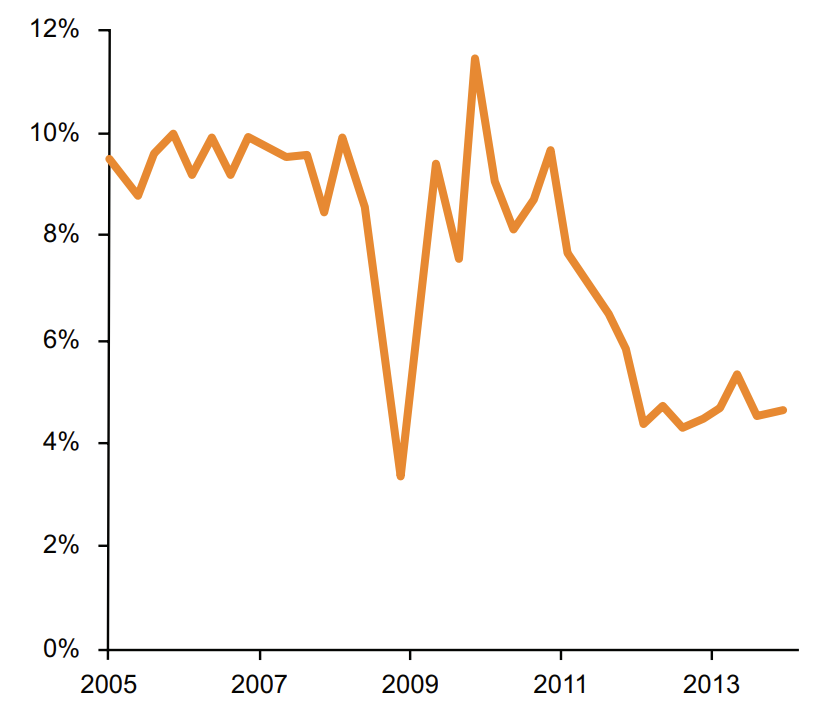
Economic Stagnation
India flourished as one of the world’s fastest-growing economies for much of the last decade. However, the past four years have seen a dispiriting collapse of growth to less than 5 percent per year, as seen in Figure 1. While not bad by global standards, it hurts in a country trying to make major advances in human development indicators like childhood malnutrition and poverty.
The main reason for this slowdown is a total collapse of investment, as seen in Figure 2. Two recent analyses by IMF economists indicate the slowdown is not due to normal business cycles or external factors. Rather, the business climate, and in particular the impact of uncertainty about government policies, appears to have made a major contribution to this slowdown.
Figure 2 — New Investment Projects
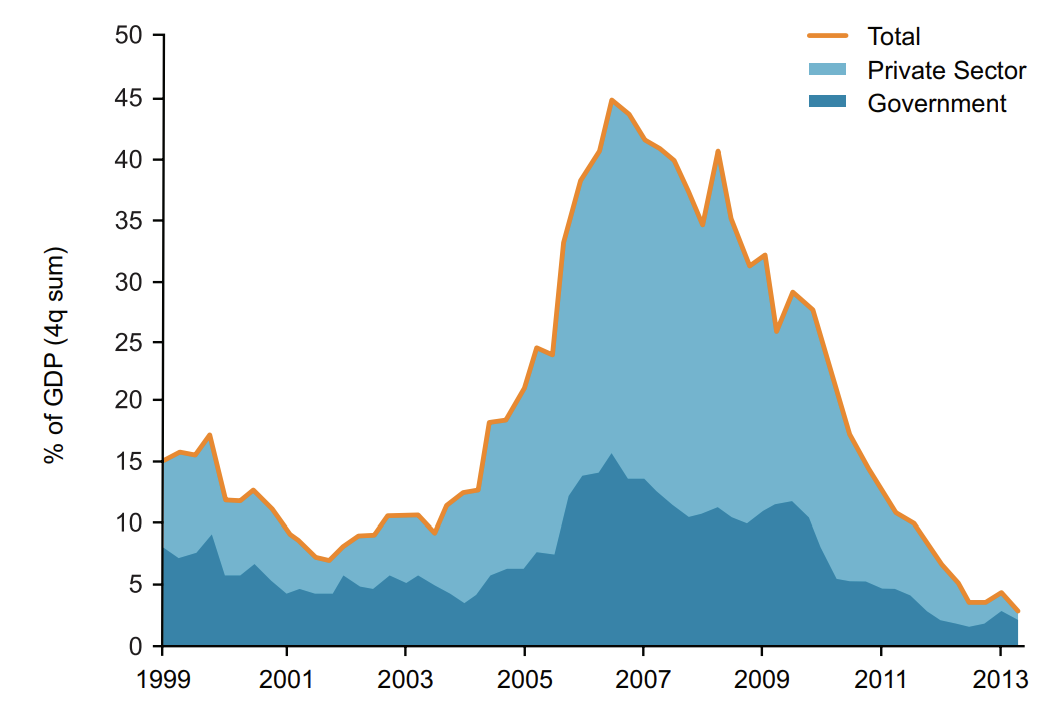
These statistical results corroborate the conventional wisdom in India. The lack of policy action to help the economy by the previous administration left businesses too uncertain or pessimistic to pursue new ventures.
Deeper Structural Flaws
A single graph, Figure 3, illustrates the major concern for India’s economic future. This graph presents the share of employment and GDP attributable to the three broad sectors of the economy. Three key features are readily apparent.
- India’s labor force is languishing in low-productivity agriculture.
- Manufacturing is too small a share of both employment and GDP.
- The service sector has led the Indian economy.
Figure 3 — Sectoral Contribution to the Economy in 2010
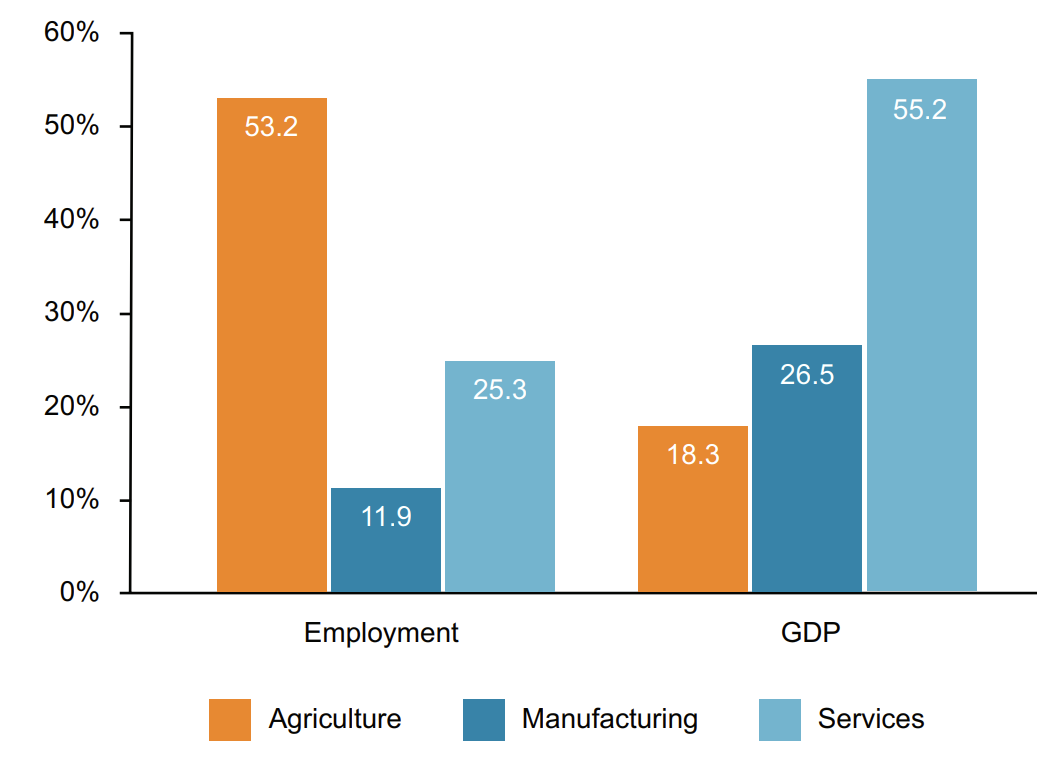
Research has shown the service industry fueled the rapid expansion of the Indian economy from 1994 to 2008.1 However, this can only take the economy so far. The outsourcing and finance segment of services that accounted for the biggest economic gains employs primarily those with postsecondary education, only about 0.7 percent of the population.
The rest of the population has very limited upward mobility. According to some estimates, half of the 48 million nonagricultural jobs added from 2004 to 2012 have been dead-end construction jobs in rural areas.2
Further, that is only half the number of new jobs India needed. As shown in Figure 4, the Indian population is relatively young, compared to the United States and especially to China. That means a beneficial ratio of workers to dependents—India’s turn to benefit from a demographic dividend—but only if working-age adults are employed. The World Bank estimates that India must create 1 million jobs a month to keep up with new job seekers.3
Rather, the best potential source of future growth lies in India’s ability to foster a manufacturing sector that can capitalize on their abundance of labor. More than half of the adult population has the schooling needed for most low-wage manufacturing jobs, and that share could rise above 60 percent in 20 years with reasonable education reform.4
Figure 4 — Population Age Distribution
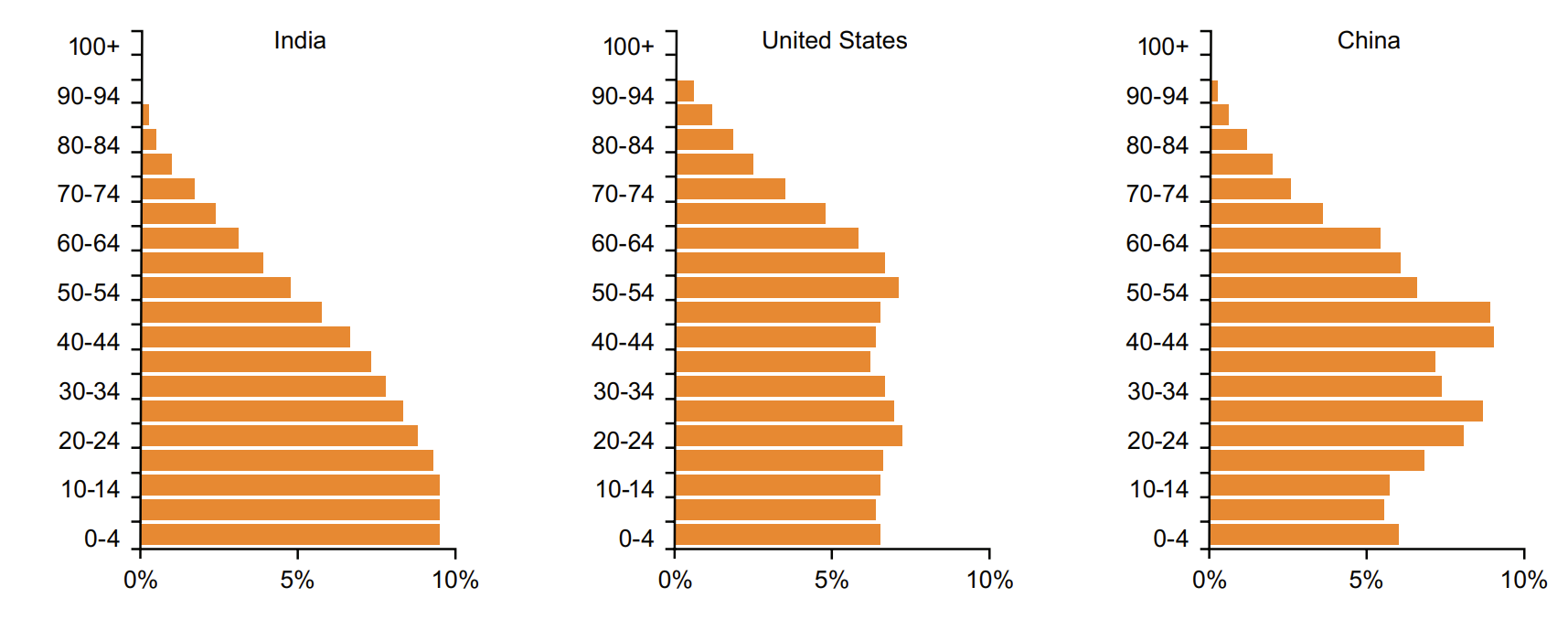
Four Reform Areas
Appropriately, Modi has stated an intention to bolster Indian manufacturing. What will the NDA need to do to accomplish this task? Broadly, the new government must target four interrelated reforms: 1) improve the business climate, 2) improve infrastructure, 3) reduce onerous labor regulations, and 4) carry out substantial institutional reforms in the government.
1. Business-government Relations
The first of these four challenges lies in the vastness of red tape surrounding Indian business. Despite major reforms in 1991, the complex web of laws and statutes regulating trade in India still suffocates markets. According to recent World Bank rankings comparing the ease of doing business in various countries, India registers at 179th best place to start a business, 186th best for contract enforcement, and 134th overall.5
The business climate naturally derives from a complex ecosystem, involving the government at many points. Reducing the friction of business-government interactions requires a multifaceted approach. Taxes can be improved by introducing a single, nationwide goods and services tax. This will also facilitate trade across states. Interaction with bureaucracies requires faster uptake of online processing options, reduction of points of contact through single-clearance windows, and winnowing of outdated regulation. Corruption must be met with aggressive approaches like the Aam Admi Party’s anti-graft helpline or Modi’s reported personal enforcement promises in Gujarat.6
Overall, the government must dive into the weeds of its administration and relentlessly hunt for the pain points where it obstructs business. Top leadership must pressure bureaucrats to seek solutions, align incentives, and restore integrity. (See Box 1 for a case study of this approach.7)
Not every obstacle must be removed. For instance, only the government can intermediate the tension between economic development and environmental protection. But even there, an emphasis on keeping things moving expeditiously and predictably can dramatically help businesses make their own decisions and proceed.
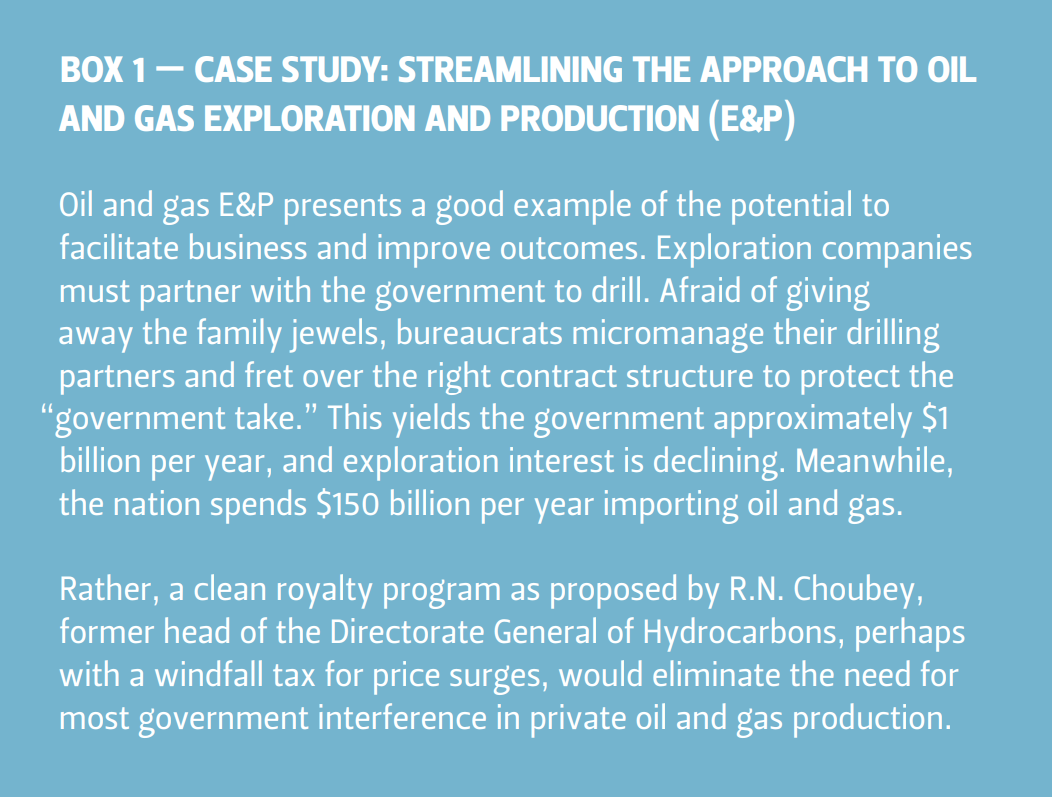
2. Provision of Public Goods
Only the government can efficiently provide certain goods. Most of these have historically been woefully insufficient in India, so a focus on getting the job done would benefit the masses who cannot afford their own personalized security force or private hospitals. Here we focus on the three most important for manufacturing: infrastructure, education, and judicial reform.
Education: The difficulty of finding qualified workers routinely lands atop surveys of businesses’ biggest gripes. In particular, factory workers should have better than basic literacy, and foremen need a high school diploma. But more than one-third of adults in India have not finished primary school, and education quality is typically low.
Improving education in India presents no more easy solutions than it does in the United States. Roadblocks include familiar complaints like rigid curricula, inadequate resources, and teachers unions that block reform. No single policy can unlock better education. Rather, the central government should encourage experimentation at the ground level with—most critically—an emphasis on measuring outcomes. A shift to outcome-based funding will necessitate major mindset and administrative changes. It would also require significant deregulation to free state-level governments to shift their approach, for instance, to a heavier investment in vocational education.
Infrastructure: The Gordian knot of infrastructure development must be addressed before growth can return. Economists estimate that fixing problems like regular power outages could yield substantial productivity gains to manufacturing.8 Yet the obstacles are multifaceted, requiring a hands-on, accountability-focused campaign to push bureaucracies and projects forward.
For instance, poor land registries precipitate confusion at the state level over what land is available for building. Infrastructure is land-intensive, but this impacts the business climate, too. Energy sector failures are largely due to incessant government meddling from upstream to the final consumer. Major decontrol must occur to meet future power needs. Finally, in the many areas where the government must remain involved, it should recognize that the social returns to infrastructure completion are immense. Excessive concern about upfront costs is penny-wise and pound-foolish. Better to focus on outcome quality, allow some subcontractors to make big profits, and let the traffic flow.
Judicial reform: The judicial structure of India shows similar need of reform. The courts are understaffed, underfunded, and unable to cope with their enormous workload. Judicial backlogs hinder contract enforcement and undermine the deterrent of law enforcement. Instead, the cost of building arrangements to address “contract instability” deters many firms from growing. The solution appears to be simple: more. More resources to pay for more manpower, more training, and more specialized courts. Accountability must improve as capacity improves, with incentives for high-caliber work.
3. Reducing Labor Regulation
Labor reform stands as such a singular impediment to manufacturing growth that it deserves particular attention. India has among the strictest labor regulations in the world. Multiple studies have documented how labor laws specifically restrict the manufacturing sector.9 They force workers into the unorganized sector, leaving the more productive organized sector a relatively small employer as seen in Figure 5.10 Hence, they directly diminish the ability of the Indian economy to generate high-quality jobs.
Figure 5 — Share of Manufacturing
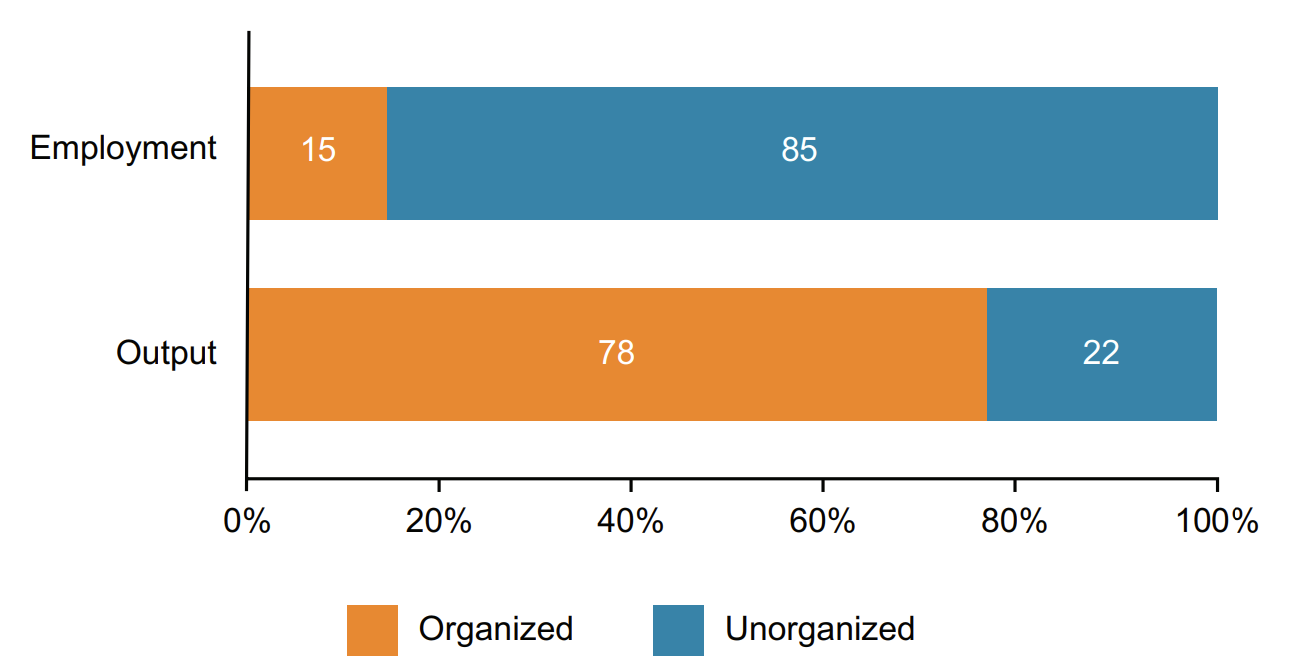
There are four dozen central laws and hundreds of state laws governing labor issues, making reform a complex topic. The OECD has done arguably the best job of organizing the various rules into themes like hiring, disputes, inspections, union rules, etc. It identified 50 broad reforms that need to be carried out across central and state governments.11 The compliance and inspection burden could also be eased without reducing the effectiveness of existing regulations.
Labor regulation deserves to be singled out also because of the unified and powerful political forces pushing to preserve it. The great challenge here is not identifying the reforms, but the political art needed to carry them out.
4. Institutional Reform
Institution building is equivalent to investing in capital stock, but India’s government has been working off of the same institutions for decades. Most factories can produce more from existing capacity for a short period, but long-term, sustainable growth requires investment. India needs a government that is more focused and capable, and there is a limit to how much even the best manager can squeeze out of the current system. First priority must be given to building accountability mechanisms, civil service reform, and privatization, each of which would help the government stay on track and perform better.
Accountability requires clear lines of authority. This means reorganizing ministries and regulators to avoid overlapping responsibilities. It also requires clear objectives and regular review of progress. The Ministry of Statistics and Programme Implementation produces no noticeable statistics on program implementation. The Planning Commission has done some excellent program evaluation work, but organizationally it is overcommitted to its planning mandate. The two should be merged into an independent Evaluation and Accountability Commission.
Civil service reform is needed to develop the depth of subject-matter expertise that modern governments require. This essentially means updating human resources (HR) policies for bureaucrats. These include increased openness to midcareer entry, more domain-specific career tracking (fewer generalists and less frequent rotation), better matching of salaries to the private sector for professional positions, and better structuring of accountability (fewer harsh punishments for mistakes, but longer tenures for better alignment of incentives).
Likewise, Modi’s institutional reform will need to extend to the privatization of India’s state-owned enterprises (locally known as Public Sector Undertakings, or PSUs). India’s PSUs face excessive government meddling— as do their counterparts around the globe. Their competitors and customers also suffer from these distortions. (How do you compete against a firm that has no profit incentive?)
Well-intentioned efforts to professionalize and revive PSUs only last as long as the good intentions. The temptation to use PSUs as an off-budget tool of public policy is too great.12 Finally, if the PSUs were made totally professional and competitive, what would be the point of government ownership? As an added incentive, privatization would raise funds for more important investment in other priorities (some listed above) while reducing the drain PSUs have on the budget.
If Modi can enact substantive institutional restructuring of PSUs, along with the courts and civil service, his government will have put India on a much sounder footing to unleash its growth potential.
What Can the NDA Government Accomplish?
If Modi successfully applies this Gujarati governance model to the central government, major gains can be achieved in the first two tough reform areas. Labor reforms may be politically tricky, but early signs are good. Institutional reform may remain a mixed bag, however, if the NDA relies on its ability to work the system rather than change it.
Getting Things Done
Modi not only has espoused a center-right economic agenda, but perhaps more importantly, he has a reputation for running his government in a business-friendly manner. In other words, more important than Gujarat’s laws was the manner in which they were carried out. Businesses report that the Gujarati government performed its job more efficiently and made the business-government interface more transparent, predictable, and smooth.
The May election has already improved accountability through the centralization of central government authority at the top with a single party in control. Pushing accountability down the ranks should facilitate the ability to follow up on personnel or procedures that impede progress and so improve execution, such as issuing permits or registering property.
Already, the notoriously slow Ministry of Environment and Forests has announced the intention to introduce time-bound clearance processes to limit unnecessary project delays. What has been branded as Modi’s CEO style of management should quickly make inroads with facilitating government clearances and output of infrastructure.
State Cooperation Remains a Challenge
Other growth impediments in the first two categories require legislative or regulatory action at the state level to make significant improvements. Finance Minister Arun Jaitley has prioritized passing the nationwide goods and services tax (GST) and has resumed the process of negotiating for state-level approval. State governments led by the Bharatiya Janata Party were the obstacles to the last government, and the opposition Congress Party has indicated support for the GST, so presumably this will move.
State-level cooperation may remain a significant impediment in other initiatives to improve the business climate and execute on infrastructure and education. Arun Maira, former member of the Planning Commission, cites analysis that two-thirds of regulations affecting manufacturing are at the state level. Similarly, infrastructure development requires consultation and cooperation with state and local entities. This helps explain why Modi was able to build such a formidable reputation.
Modi has indicated a desire for greater inclusion of state governments in central processes. This will help. But state-level governments on average suffer from a much greater need for institutional reform than the central government. Without better capabilities, state-level implementation will remain inadequate.
Budget Action Unlikely
Some important steps could begin with the initial budget to be presented next month. Unfortunately, shifting greater autonomy to states on education spending along with greater emphasis on program evaluation has not appeared to be a priority. There are no indications that greater funding for the judicial system will be given, either.
Both of these reforms intersect the complex electoral system in ways that frighten politicians. Teachers, besides being unionized, are also an integral part of the voting machinery, manning voting stations in schools. And the links between criminality and elected representatives have been well documented elsewhere.13 Action on these items will languish absent the development of external motivation.
Toughest of the Tough
The second two reform areas present bigger challenges to the new administration. Organized labor and leftist parties have historically put up stiff resistance. Fortunately, since the parties most closely linked with labor were weakened in the May elections, labor reform has already seen some positive developments. The central government may give states like Rajasthan leeway to begin state-level flexibility and experimentation with adjusting central labor laws. Further, the central government Labor Ministry plans to reduce the burden of compliance and inspection related to existing laws.
Major institutional reforms are the big question mark for the Modi administration. It will take much more than reducing the number of cabinet ministers, eliminating committee decision-making in the cabinet, and direct reporting of cabinet secretaries. Yet these are all good starts. Reforming—rather than scuppering—the Planning Commission would be the next natural step, since it has already devised its own reform plan. Resistance will come from those who dislike objective oversight, which is just about everyone.
Conclusion
Identifying important reforms is a relatively easy job in India because of the plethora of expert committee reports on so many topics. The challenge is in implementation. India may therefore face a watershed moment when a prime minister known for getting things done has an unusually strong political base from which to act. He has indicated that reviving manufacturing is a critical priority for his administration, and its earliest moves back this up. Finally, the demographic dividend of young workers presents perhaps the last good opportunity India will have to experience sustained, high economic growth, and it can only happen through expanding manufacturing. The new government has all the right pieces to enact the four tough reforms and reignite India’s economy.
Endnotes
1. Barry Eichengreen and Poonam Gupta, The Service Sector as India’s Road to Economic Growth, Research report no. 16757, NBER Working Paper Series (Cambridge, MA: National Bureau of Economic Research, 2011).
2. Jayan Jose Thomas, “The Demographic Challenge and Employment Growth in India,” Economic & Political Weekly 49, no. 6 (2011).
3. “One Million New Jobs Needed Each Month to Sustain Growth and Reduce Poverty in South Asia,” The World Bank, September 21, 2011, accessed June 4, 2014, http://www.worldbank.org/en/news/feature/2011/09/21/one-million-new-jobs-needed-month-sustain-growth-reduce-poverty-south-asia.
4. Workers who have attained the schooling needed for manufacturing includes those completing primary or secondary education, but no tertiary education. The Wittgenstein Centre for Demography and Global Human Capital has educational attainment forecasts for 120 countries. http://www.oeaw.ac.at/wic.
5. The World Bank, “Economy Rankings,” accessed June 23, 2014, http://doingbusiness.org/rankings.
6. Anecdotally, Modi requested investors to report back to him personally any experience with corruption, so that he could deal with it directly.
7. The case study relies heavily on the Kelkar Committee Report, Roadmap for Reduction in Import Dependency in Hydrocarbon Sector by 2030 — Part I (Ministry of Petroleum of India, 2014), accessed June 10, 2014, http://petroleum.nic.in/kelkar.pdf.
8. Hunt Allcott, Allan Collard-Wexler, and Stephen D. O’Connell, How Do Electricity Shortages Affect Productivity? Evidence from India, NBER Working Paper No. w19977, March 23, 2014, accessed June 4, 2014, http://pages.stern.nyu.edu/~acollard/ACO_ Electricity_Shortages_in_India.pdf.
9. Arvind Panagariya, India: The Emerging Giant (New York: Oxford University Press, 2008); Sean Dougherty, Richard Herd, and Thomas Chalaux, “What is Holding Back Productivity Growth in India? Recent Microevidence,” OECD Economic Studies 45, no. 1 (2009): 59–80; Rana Hasan and Karl Robert Jandoc, “Labour regulations and the firm size distribution in Indian manufacturing,” in Reforms and Economic Transformation in India, ed. J. Bhagwati and A. Panagariya (New York: Oxford University Press, 2012).
10. Source data for the graph comes from Santosh Mehrotra, Ankita Gandhi, and Bimal Kishore Sahoo, Organised and Unorganised Employment in the Non-Agriculture Sectors in the 2000s, IAMR Occasional Paper No. 6/2012 (Institute of Applied Manpower Research, 2012), http://www.iamrindia.gov.in/final%20Organised-Unorganised%20paper%20for%20website.pdf.
11. OECD, OECD Economic Surveys: India, 2007, Volume 2007/14 (OECD Publishing, 2007). Another good and more recent report is by the Planning Commission, Government of India, Survey on Business Regulatory Environment for Manufacturing — State Level Assessment, March 2014.
12. A good example of how economists think about this problem can be found in Andrei Shleifer and Robert W. Vishny, “Politicians and Firms,” The Quarterly Journal of Economics 109, no. (1994): 995–1,025.
13. See Bhaskar Dutta and Poonam Gupta, How Indian Voters Respond to Candidates with Criminal Charges: Evidence from the 2009 Lok Sabha Elections, Working Paper No. 2012-109 (New Delhi: National Institute of Public Finance and Policy, 2012). See also Raymond Fisman, Florian Schulz, and Vikrant Vig, Private Returns to Public Office, NBER Working Paper No. 18095, May 2012, http://nber.org/papers/w18095.
This material may be quoted or reproduced without prior permission, provided appropriate credit is given to the author and Rice University’s Baker Institute for Public Policy. The views expressed herein are those of the individual author(s), and do not necessarily represent the views of Rice University’s Baker Institute for Public Policy.


